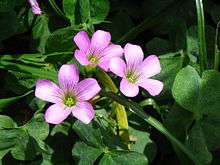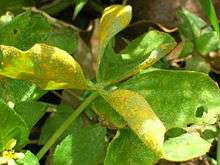Oxalis debilis
Oxalis debilis, the large-flowered pink-sorrel[2] or pink woodsorrel,[1] is a perennial plant and herb in the family Oxalidaceae.[1] Its original distribution is South America but has become a very cosmopolitan species, occurring in all continents except Antarctica. It can be found in both temperate and tropical areas.[3]
| Oxalis debilis | |
|---|---|
 | |
| Scientific classification | |
| Kingdom: | Plantae |
| Clade: | Tracheophytes |
| Clade: | Angiosperms |
| Clade: | Eudicots |
| Clade: | Rosids |
| Order: | Oxalidales |
| Family: | Oxalidaceae |
| Genus: | Oxalis |
| Species: | O. debilis |
| Binomial name | |
| Oxalis debilis | |
| Varieties | |
|
See text | |
The flowers, leaves and roots are edible. There is concern that the plant should only be consumed in small amounts because it contains oxalic acid that can cause calcium deficiency if eaten in larger amounts.[4] Studies show that this is an exaggerated fear.[5] The leaves have what is considered a zesty lemony flavor.
Description
It is a bulbous plant. The fruit is a capsule. The seeds are projected, with an elastic integument. In Europe the plants are sterile and are propagating only by bulbs.[6]
Research on the naturalizing populations in China show the presence of 2 flower morphs, pollen with low viability and polyploidy.[7]
Varieties and cultivation
There are two varieties:
- Oxalis debilis var. corymbosa (DC.) Lourteig – large-flowered pink-sorrel (Synonym : O. corymbosa)
- Oxalis debilis var. debilis
'Aureoreticulata' ('aureo-reticulata') has attractive variegated leaves with flowers that are pinkish purple.[3] This cultivar is also named ‘Gold Veined Oxalis’ (Yellow Vein Oxalis) with attractive yellow vein foliage. The symptom is associated with the presence of a begomovirus. This virus, designated OxYVV, is transmitted by the whitefly Bemisia tabaci.[8]
The Royal Horticultural Society advises that it can be a serious weed.[9]
Pests and diseases

Puccinia oxalidis is a fungus species in the genus Puccinia. This species is a causal agent of rust on plants in the genus Oxalis.
See also
- List of the vascular plants of Britain and Ireland 6
- List of vascular plants of Norfolk Island
References
- "Oxalis debilis". Natural Resources Conservation Service PLANTS Database. USDA. Retrieved 30 January 2016.
- "BSBI List 2007". Botanical Society of Britain and Ireland. Archived from the original (xls) on 2015-01-25. Retrieved 2014-10-17.
- "Pacific Bulb Society - Miscellaneous Oxalis".
- "Oxalis debilis var. corymbosa - Pink Wood Sorrel, Pink Woodsorrel, Lilac Oxalis, Large-flowered Pink Sorrel - Hawaiian Plants and Tropical Flowers".
- http://dietary-supplements.info.nih.gov/factsheets/calcium.asp "Other components in food: phytic acid and oxalic acid, found naturally in some plants, bind to calcium and can inhibit its absorption. Foods with high levels of oxalic acid include spinach, collard greens, sweet potatoes, rhubarb, and beans. Among the foods high in phytic acid are fiber-containing whole-grain products and wheat bran, beans, seeds, nuts, and soy isolates. The extent to which these compounds affect calcium absorption varies. Research shows, for example, that eating spinach and milk at the same time reduces absorption of the calcium in milk. In contrast, wheat products (with the exception of wheat bran) do not appear to have a negative impact on calcium absorption. For people who eat a variety of foods, these interactions probably have little or no nutritional consequence and, furthermore, are accounted for in the overall calcium DRIs, which take absorption into account."
- "Oxalis debilis var. corymbosa".
- Luo, S.; Zhang, D; Renner, S. S. (2006). "Oxalis debilis in China: Distribution of Flower Morphs, Sterile Pollen and Polyploidy". Annals of Botany. 98 (2): 459–64. doi:10.1093/aob/mcl121. PMC 803464. PMID 16735406.
- Herrera, Favio; Aboughanem-Sabanadzovic, Nina; Valverde, Rodrigo A. (2015). "A begomovirus associated with yellow vein symptoms of Oxalis debilis". European Journal of Plant Pathology. 142: 203. doi:10.1007/s10658-015-0594-y.
- "Oxalis".
- . W. H. A. von Humboldt et al., Nov. gen. sp. 5:183[folio]; 5:236[quarto]. 1822
External links
![]()